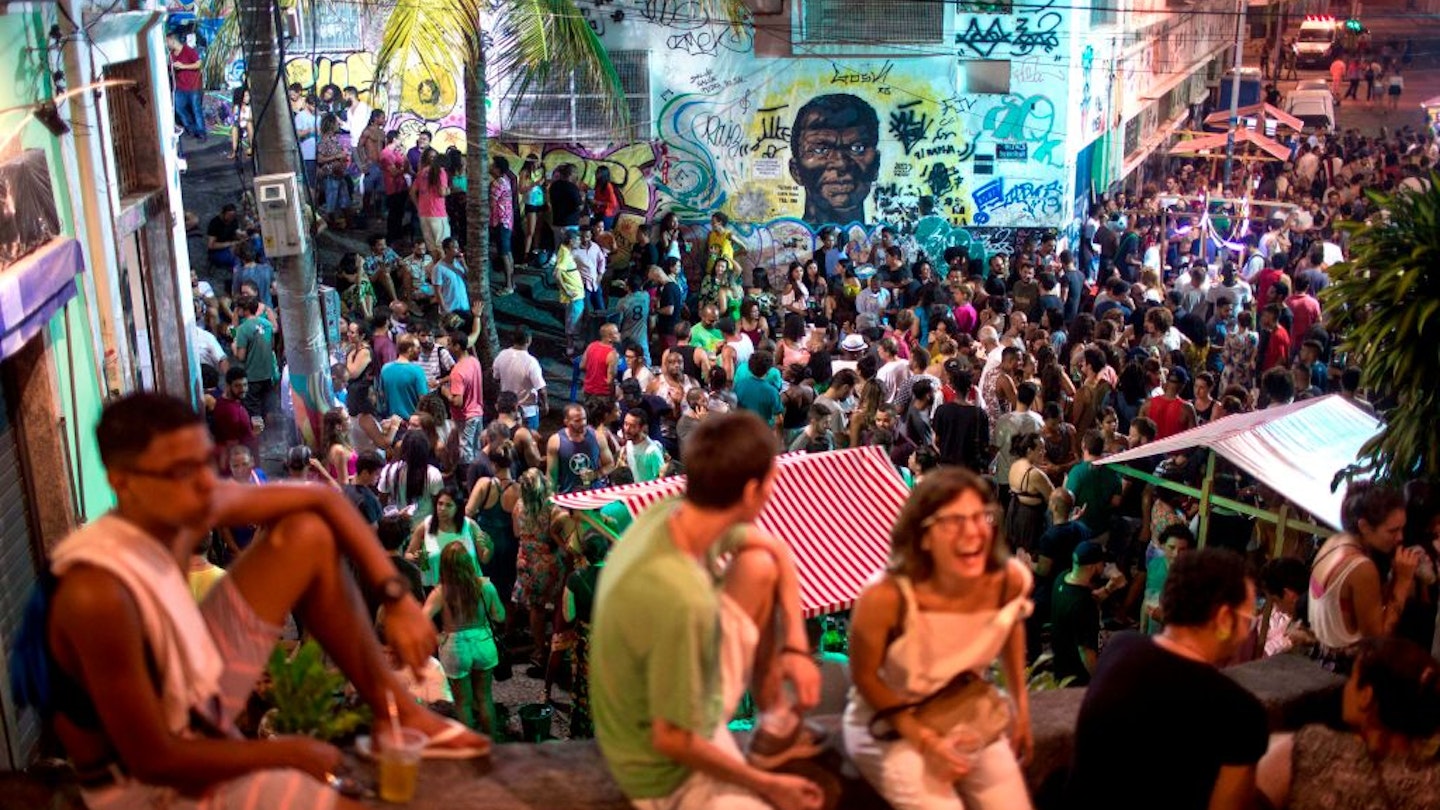Writer Georgina Lawton has visited Rio before. However, on a recent trip, she traveled through the city with a clear mission to uncover its African heritage.
A blue sky – naked except for the burning midday sun – radiated a heat so heavy that I was almost wilting as I strolled through a market in Rio de Janeiro. As I pulled my hair up and off my neck, I ambled past street stalls loaded with neon bikinis and bottles of molho de pimenta, a fiery hot sauce. I ducked beneath long, green sugarcane stalks balanced precariously on the shoulders of shirtless men and weaved around children selling sweets and cigarettes beneath bright umbrellas.
The Rio neighborhood of Madureira is 70% Black and situated 40 minutes from Copacabana in the city’s North Zone. It rarely tops any “must-see” tourist lists, but I came to the city on a mission to uncover Rio’s African roots, so I made like the Cariocas and acted unbothered by the sweltering temperatures.
Experiencing Carnival in Rio
It was my second time in Rio and at Carnival. The first time, in 2019, Cariocas took me to street parties and helped me source rides home. I remember marveling at their openness. I felt joy seeing brown bodies of every shape, shade, and size jiggling in the sun, slicked with glitter. This time, I wanted to dig beyond the in-your-face hedonism of Carnival. I already knew that Brazil’s greatest cultural export, Carnival, had primarily been built on the backs of Black Brazilians. Nevertheless, to many visitors, the influence of a vibrant and adaptive African diaspora isn’t immediately visible, as images of lithe and light Carnival queens persist.
Neighborhoods, Worlds Apart
In Madureira, I met Rayanne Moreira, a friend of a friend. “You blend in so well I wasn’t sure if it was you,” Rayanne said, laughing when she arrived. I would hear this frequently. As a Black woman, in Madureira I could trick people into thinking I was a local – as long as I didn’t open my mouth.
Moreira guided me through Mercadão de Madureira, a bustling shopping destination. Stores sell homeware, clothes, and electronics, making it a place where you could buy nearly anything except the souvenir keyrings and trinkets I’d seen in central Rio. I picked up a diamante belt and braiding hair, astonished at the bargain prices. Over a snack of chicken pastries and sugarcane juice, Moreira, who has grown up in Madureira, explained that her neighborhood houses some of the most famous samba schools in Rio, and that informal Carnival celebrations would still be happening, even if the official events were canceled.
Understanding Afro-Brazilian Culture
Moreira, who had a similar hair texture and complexion to mine except for a smattering of freckles across her face and blonde hair, was dressed in all white. She explained this was for a “purification period” dictated by her religion. Originating from the Yoruba people in Nigeria, Ifá is one of Brazil’s African religions, with Candomblé and Umbanda being more commonly practiced.
“They’ve been stigmatized for centuries,” Moreira told me. “Things are getting better slowly.” Brazil, although officially secular, has been deeply influenced by Catholic teachings for generations. In 1890, the Penal Code outlawed the practice of Afro-Brazilian religions, equating them with black magic. Enslaved people fused their deities, known as orixás, with Roman Catholic saints, enabling secret worship. These religions often represent a fusion of Catholic traditions with West African spirituality, yet such terminology can obscure their painful roots, essential for survival and hope.
Uncovering History
The next day, I made my way to the Pequena África (Little Africa) neighborhood with tour guides Lua Ferreira and Eddie Vander. After Madureira, Little Africa serves as the city’s second epicenter of African culture. We began our day in Mauá Square, where Ferreira expressed the significance of Black tour guides leading a Black journalist in a Black neighborhood in Rio. This was a rare but special experience.
As we walked through the square, beautifully transformed since its dilapidated state, we arrived at the stunning Museum of Tomorrow, dedicated to addressing our planet’s future. Ferreira greeted families in the street and engaged with construction workers, demonstrating the close-knit community atmosphere.
The Spirit of Samba
Eventually, we reached Francisco da Prainha Square, home to a statue of Mercedes Batista, the first Black female dancer in Rio’s Municipal Theater. Ferreira emphasized how important it was to celebrate figures like Mercedes. Nearby lies Pedro do Sal, once a site where enslaved Africans were forced to break salt; it became the first community for free and escaped slaves, known as a quilombo. Today, Pedro do Sal is a popular spot for open-air samba parties.
Despite witnessing the tragedies of the past, I was filled with hope as we joined a bloco, a Brazilian street party, later that night. Sandwiched among a sea of bodies shiny with sweat, I swayed to samba and joined in chants against political figures. Engaging with Eddie’s friends felt seamless, as if I were surrounded by family.
Through this exploration of Rio, I realized the depth of connection we share with our roots, and how every rhythm of samba resonates with a history that needs to be honored and preserved.





